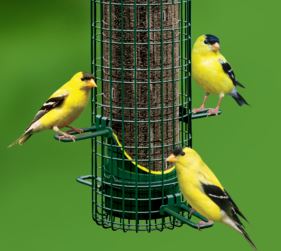
Goldfinches
The American goldfinch (Carduelis tristis ) is a common songbird found throughout the U.S. and fairly easy to attract to your feeder. This small bird (about 4 – 5 inches in length) is most commonly identified by the male, with its bright yellow body, black and white striped wings and a black cap. Adult females have duller yellow feathers, and lack the black cap. You would normally not see goldfinches while hiking in the forest, rather their preferred habitat is grassland with scattered trees and other semi-open areas. 
A sure sign of fall is the “disappearance” of these yellow goldfinches. However, they haven’t migrated out of the area, the males have only molted into their winter plumage. This molting may take a week or more and their bodies will appear patchy during this time. In the spring, you will again be treated to their beloved bright yellow hue, when the males molt once again. American goldfinches are one of the few songbirds that molt twice a year.
The best way to attract goldfinches to your feeder is to give them their favorite food – Nyjer seed. This seed is often called thistle seed but it is not the seed of the thistle plant but rather from the Guizotia abyssinica, a sunflower type plant from Africa. Nyjer seed is a tiny, oblong black seed and is best put into a specific Nyjer feeder as it would fall out of a feeder with large port openings. Since goldfinches are clinger birds, they have the ability to perch in any position, even upside down. Nyjer feeders are often made of a mesh material, allowing the goldfinches to cling anywhere on the feeder, and use their cone shaped bills, to peck and grab a seed. The mesh material can be metal or fabric; the fabric kind often being call a sock. Goldfinches will also feed at tube feeders or platform feeders with a good mix of seed containing sunflower seed. And in spring, goldfinches often eat the small seeds from dandelions.
Gardeners can attract goldfinches to their yard by growing purple coneflower, black-eyed susan, sunflowers, and asters including native thistles. Native thistles include Bristle Thistle (Carduus nutans) and Bull Thistle (Cirsium vulgare). Again, their clinging ability allows them to hang on to the flowers and peck at the seed heads, even as their weight bends the stalk down. After they’ve bloomed, don’t deadhead the flowers but allow them to go to seed in order to attract the goldfinches.
Native thistle plants are important to goldfinches also around nesting season. The American goldfinch is a late nester, waiting until late June or July to build a nest, when thistle, milkweed and other plants form their fibrous seeds. The seeds are eaten by the adults and young, and the fibers are incorporated into the nest. The nest is an open top, approximately 3 inches across, in a bowl shape with a slightly cone bottom. It is tightly woven from small roots and plant fibers and lined with plant down and spider silk. This tight weave makes the nest essentially waterproof. The male and female choose a suitable site, followed by the female building the nest high in a shrub. Often the nest will be viewable from below but hidden from an aerial view by leaves from higher branches on the shrub. Goldfinches will have 1 or 2 broods per year, with up to 6 light blue eggs per brood. Goldfinch chicks are not fed insects like many other songbirds. They eat the same seeds that their parents do, making them rather strict vegetarians.
Since goldfinches are not cavity nesters, they are less likely to use a birdhouse than, for example, a woodpecker. However, you can try to entice these finches to nest in your yard with a proper size birdhouse. The house should be about 12 inches tall, 6 inches wide, 8 inches deep, with an entrance hole at least 1.5 inches in diameter, and mount the birdhouse in a shrub or sapling 5 – 10 feet from the ground. Other birds may take over the house but just be on alert for that nasty invasive House Sparrow.




Hello , I tried in July with a thistle feeder , unfortunately the only thing I attracted were the squirrels, tried to hang them high . No sign of finches. Any suggestions appreciated. Thank you
Hi Claire,
Sometimes squirrels are attracted to nyjer (also know as thistle) but it’s not their favorite food since the seeds are so small. You don’t say what kind of feeder you have but if you select one that is made of a metal mesh or has metal around the ports where the birds take the seeds, it should mostly stop squirrels. They won’t be able to chew and damage the feeder.
Goldfinches are notoriously finicky feeders and if the nyjer that was in the feeder was more than a few months old, the goldfinches will not eat it. I recommend emptying your feeder, making sure there’s no mold or clumped seeds at the bottom. Then fill the feeder with fresh seed. The Bird House gets seed delivered every week so you’re assured that our supply is not old. I recommend getting just a pound or two of nyjer and see how it goes. Sometimes it can take birds a couple weeks to find a new feeder if they’re not used to finding food in your yard.
Thanks for being a bird lover, and give us a call at (585) 264-1550 if you have any other questions.
Can purchase a Goldfinch house through you?
Hi Susan,
Actually, the American Goldfinch is one of the songbirds that doesn’t use a box or house to build it’s nest. They choose a spot in a shrub or short tree during June/July and construct their nest out out of milkweed and other fibrous seeds. If you’re trying to attract goldfinches to nest in your yard, try planting milkweeds.
Thanks for your question.